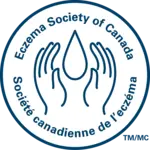Contact dermatitis, and how it differs from other forms of eczema
 Eczema in an umbrella term used to describe a number of conditions, including atopic dermatitis, contact dermatitis, chronic hand eczema, sebhorric eczema, and others.
Eczema in an umbrella term used to describe a number of conditions, including atopic dermatitis, contact dermatitis, chronic hand eczema, sebhorric eczema, and others.
ESC recently asked paediatric dermatologist Marissa Joseph, MD, FRCPC to teach us the difference between contact dermatitis and other forms of eczema. She told us this:
“Contact dermatitis is a type of eczema that happens when the skin becomes irritated after coming into contact with an irritating substance. There are two forms of contact dermatitis: irritant and allergic. Both are distinct and treated differently.
Irritant contact dermatitis accounts for approximately 80% of all contact dermatitis and occurs when skin cells are damaged by coming into contact with an irritating substance, such as scratchy wool or excessive amounts of hand sanitizer.
Allergic contact dermatitis is an immune response in an area of the skin that has been exposed to a substance that triggered the allergic reaction.”
Though AD and contact dermatitis are distinct types of eczema, Dr. Joseph explained, “the two can be related, because if you have atopic dermatitis which is genetically sensitive skin, you may be more likely to have contact allergies to many different things, which is why what you put on your skin is so important.”
If you are experiencing symptoms that you think are related to contact dermatitis, speak to your doctor to learn what you can do to alleviate them.
Eczema Society of Canada (ESC) thanks Marissa Joseph, MD, FRCPC, for sharing her expertise during ESC’s March 2022 Life with Eczema virtual event series and on this content. Funding for the Life with Eczema Winter 2022 event series was generously provided by Pfizer Canada and Sanofi Genzyme, a division of sanofi-aventis Canada Inc.
Disclaimer: Information provided in this resource does not constitute medical advice and is not intended to be used as a diagnostic tool. The information is up-to-date at time of publication. All medications, interventions, and treatment plans have risks and benefits, and it is important that individuals discuss their or their child’s specific health care needs with a qualified health care professional.
March 2022



